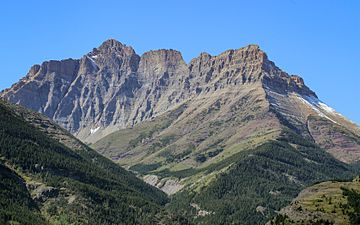Mount Blakiston facts for kids
Quick facts for kids Mount Blakiston |
|
|---|---|

Mount Blakiston
|
|
| Highest point | |
| Elevation | 2,910 m (9,550 ft) |
| Prominence | 1,149 m (3,770 ft) |
| Parent peak | Kintla Peak 3071 m |
| Listing | Mountains of Alberta |
| Geography | |
| Parent range | Clark Range |
| Topo map | NTS 82G/01 |
| Climbing | |
| First ascent | Unknown |
| Easiest route | Moderate scramble |
Mount Blakiston is a tall mountain located in the southwestern part of Alberta, Canada. It is the highest point inside Waterton Lakes National Park. This mountain is part of the Clark Range. It sits between Lineham Creek to the north and Blakiston Creek to the south. Close by are Mount Hawkins, which is 2,685 meters (8,809 feet) tall, and Mount Lineham, which is 2,728 meters (8,950 feet) tall.
The mountain got its name in 1858. It was named after Thomas Blakiston, who was part of the Palliser Expedition. This expedition explored parts of western Canada.
Contents
Exploring Mount Blakiston
You can find a hiking trail called Lineham Creek that goes along the southern side of Mount Blakiston. For people who enjoy climbing rocky slopes, the mountain's southern side offers a good way to reach the top. This path is steep and has many loose rocks.
In 1942, two climbers named J. Gibson and G. Williams reached the summit. They found a small pile of rocks, called a cairn, that someone else had built. This means that the very first people to climb Mount Blakiston are not known.
How Mount Blakiston Was Formed
Understanding the Rocks
Just like other mountains in Waterton Lakes National Park, Mount Blakiston is made of sedimentary rock. This type of rock forms from layers of sand, mud, and other materials that build up over millions of years. These layers were laid down during ancient time periods, from the Precambrian to the Jurassic periods.
The Laramide Orogeny
These rocks first formed in shallow seas. Later, a huge event called the Laramide orogeny happened. This was a time when Earth's crust moved a lot. During this event, the older sedimentary rock was pushed up and over younger rock layers. This is how the mountain got its shape.
Weather at Mount Blakiston
What is a Subarctic Climate?
Mount Blakiston has a subarctic climate. This means it has very cold and snowy winters. The summers are usually mild, not too hot.
Winter Temperatures
During winter, temperatures can drop below -20 degrees Celsius (-4 degrees Fahrenheit). When you add in the wind, it can feel even colder, sometimes below -30 degrees Celsius (-22 degrees Fahrenheit).



